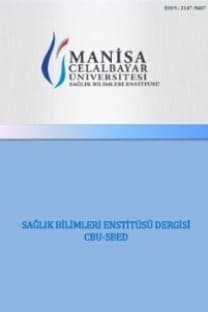Genç Erişkinlerde Ayağın Yüklenmeye Verdiği Cevabın İncelenmesi Ve Cinsiyete Göre Karşılaştırılması
___
1. McKeon, PO, Hertel, J, Bramble, D, Davis, I, The foot core system: a new paradigm for understanding intrinsic foot muscle function, British Association of Sport and Medicine, 2015, 49(5), 290-290.2. Zelik, KE, La Scaleia, V, Ivanenko, YP, Lacquaniti, F, Coordination of intrinsic and extrinsic foot muscles during walking, European journal of applied physiology, 2015, 115(4): 691-701.
3. Jastifer, JR, Gustafson, PA, The subtalar joint: Biomechanics and functional representations in the literature, The Foot, 2014, 24 (4): 203-209.
4. Kelikian, AS, Sarrafian, SK, Sarrafian's anatomy of the foot and ankle: descriptive, topographic, functional. Lippincott Williams & Wilkins.2011.
5. Rodgers, MM, Dynamic foot biomechanics, Journal of Orthopaedic & Sports Physical Therapy, 1995, 21(6): 306- 316.
6. Hutchinson, ID, Baxter, JR, Gilbert, S, Hogan V, MaCalus, Ling, Jeff, Saunders, Stuart M, Wang, Hongsheng, Kennedy, John G, How do hindfoot fusions affect ankle biomechanics: a cadaver model, Clinical Orthopaedics and Related Research, 2016, 474 (4): 1008-1016.
7. Jarvis, HL, Nester, CJ, Bowden, PD Jones, RK, Challenging the foundations of the clinical model of foot function: further evidence that the root model assessments fail to appropriately classify foot function. Journal of foot and ankle research, 2017, 10 (1): 7.
8. Cowling, EJ, Steele, JR. Is lower limb muscle synchrony during landing affected by gender? Implications for variations in ACL injury rates, Journal of Electromyography and Kinesiology ,2001, 11(4): 263-268.
9. Hosea, TM, Carey, CC, Harrer, MF, The gender issue: epidemiology of ankle injuries in athletes who participate in basketball, Clinical Orthopaedics and Related Research®, 2000, 372: 45-49.
10. Krauss, I, Grau, S, Mauch, M Maiwald, C, Horstmann, T, Sex-related differences in foot shape, Ergonomics, 2008; 51(11): 1693-1709.
11. Kaya, H, Özçelik, O, Vücut Bileşimlerinin Değerlendirilmesinde Vücut Kitle İndeksi ve Biyoelektrik İmpedans Analiz Metodlarının Etkinliğinin Yaş ve Cinsiyete Göre Karşılaştırılması, Fırat Üniversitesi Sağlık Bilimleri Tıp Dergisi, 2009, 23(1): 1-5.
12. Kernozek, TW, Torry, MR, Van Hoof, H, Cowley, H, Tanner, S, Gender differences in frontal and sagittal plane biomechanics during drop landings, Medicine & Science in Sports & Exercise, 2005; 37 (6): 1003-1012.
13. Öğce, F, Özyalçın, H, Özkan, S. Characteristics of Foot Ailments in Ege Region, Turkiye Klinikleri Journal of Medical Sciences, 2010, 30(1): 97-106.
14. De Cock, A, De Clercq, D, Willems, T, Witvrouw, E, Temporal characteristics of foot roll-over during barefoot jogging: reference data for young adults, Gait&Posture, 2005, 21(4): 432-439.
15. Decker, MJ, Torry ,MR, Wyland, DJ, Sterett, WI, Steadman, JR, Gender differences in lower extremity kinematics, kinetics and energy absorption during landing, Clinical biomechanics, 2003, 18(7): 662-669.
16. Wojtys, EM, Huston,, LJ, Schock, HJ, Boylan, JP, Ashton- Miller, JA, Gender differences in muscular protection of the knee in torsion in size-matched athletes, The Journal of Bone & Joint Surgery, 2003, 85(5): 782-789.
17. Song, J, Choe K, Neary, Zifchock, RA, Cameron, KL, Trepa, M, Hannan, MT, Hillstrom, H, Comprehensive biomechanical characterization of feet in USMA cadets: comparison across race, gender, arch flexibility, and foot types, Gait&Posture, 2018, 60: 175-180.
18. Koo, S, Chun, S, Lee, KM, Cho, BC, Koo, YJ, Kang, DW, Park, MS, Sex Differences in Pedobarographic Findings and Relationship between Radiographic and Pedobarographic Measurements in Young Healthy Adults, Clinics in orthopedic surgery, 2018; 10(2, 216- 224.
19. Faria A, Gabriel, R, Moreira, H, Camacho, T, Brás, R, Ditroilo, M, The effect of sex and localised fatigue on triceps surae musculoarticular stiffness, European journal of sport science, 2018, 18(4): 483-490.
20. Cote, KP, Brunet, ME, Gansneder, BM, Shultz, SJ, Effects of pronated and supinated foot postures on static and dynamic postural stability, Journal of athletic training, 2005, 40: 41-46.
21. Springett, KP, Whiting, MF, Marriott,C, Epidemiology of plantar forefoot corns and callus, and the influence of dominant side, The Foot ,2003,13 (1):5-9.
22. Dawson, J, Thorogood, M, Marks, SA, Juszczak, E, Dodd, C, Lavis, G, Fitzpatrick, R, The prevalence of foot problems in older women: a cause for concern, Journal of Public Health, 2002,24(2):77- 84.
23. Ayub, A, Yale, SH, Bibbo, C, Common foot disorders, Clinical Medicine & Research, 2005,3(2):116-9.
24. Nyska, M, Liberson, A, McCabe, C, Linge, K, Klenerman, L, Plantar foot pressure distribution in patients with hallux valgus treated by distal soft tissue procedure and proximal metatarsal osteotomy, Foot and ankle Surgery,1998;4(1):35-41.
25. Cosman, F, Ruffing, J, Zion, M, Uhorchak, J, Ralston, S, Tendy, S, McGuigan, FEA , Lindsa, R, Nieves, J, Determinants of stress fracture risk in United States Military Academy cadets, Bone, 2013, 55: 359–366.
26. Levy, JC, Mizel, MS, Wilson, LS, Fox, W, McHale, K, Taylor, DC, Temple, HT, Incidence of foot and ankle injuries in West Point cadets with pes planus compared to the general cadet population, Foot & ankle international, 2006; 27: 1060–1064.
- ISSN: 2147-9607
- Yayın Aralığı: Yılda 4 Sayı
- Başlangıç: 2014
- Yayıncı: Manisa Celal Bayar Üniversitesi Sağlık Bilimleri Enstitüsü
Sağlık Teknikerliği Öğrencilerinin Benlik Saygısı Düzeyi ve İlişkili Etmenler
Prematüre Retinopatisi Tedavi Sonuçlarımız
Hüseyin MAYALI, Cansu SARIGUÜL, Emin KURT, Özcan KAYIKÇIOĞLU, Süleyman İLKER
Prematürite Retinopatisi Tedavi Sonuçlarımız
Hüseyin MAYALI, Cansu SARIGÜL, Emin KURT, Özcan Rasim KAYIKÇIOĞLU, Süleyman Sami İLKER
Overweight and Obesity in Preschoolers in a Region in Western Turkey and Related Factors
Celalettin CEVİK, Sibel ERGUN, Ayşe KARADAŞ, Turkan CALISKAN, Nuriye KARADAG
Evaluation of Early and Mid-term Results of TEVAR Procedures with Various Etiology
Dilşad Amanvermez ŞENARSLAN, Funda YILDIRIM, Ömer TETİK
İnsan Amniyon Sıvısı Kökenli Mezenkimal Kök Hücrelerin İmmunosupresyon Etkileri: Treg Regülasyonu
ONUR UYSAL, Tuğba SEVİMLİ, Sibel GÜNEŞ, Ahmad TOKHİ, Ceren ÖZEL, Ayla SARIBOYACI
Evaluation of Early and Mid-term Results of TEVAR Procedures with Various Etiology.
